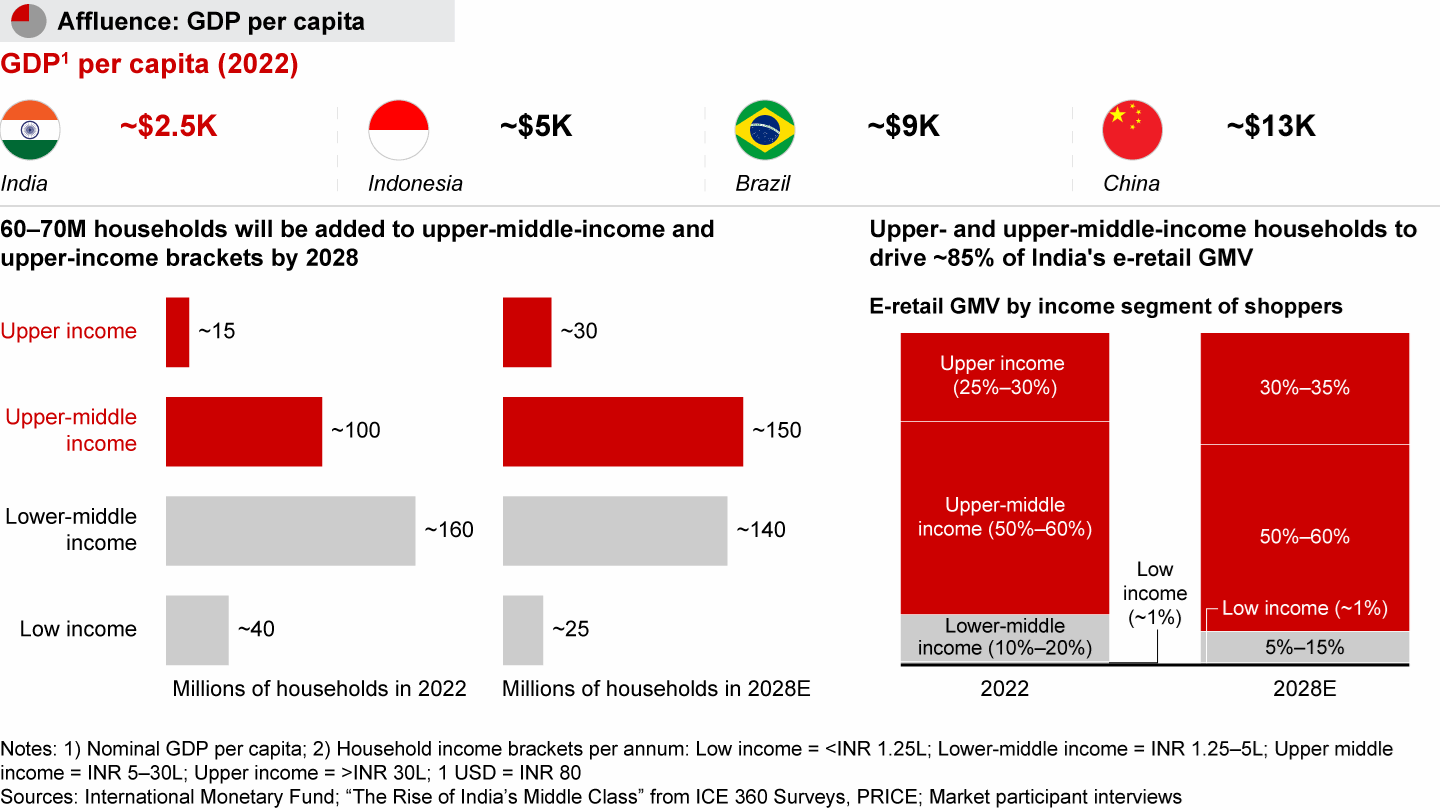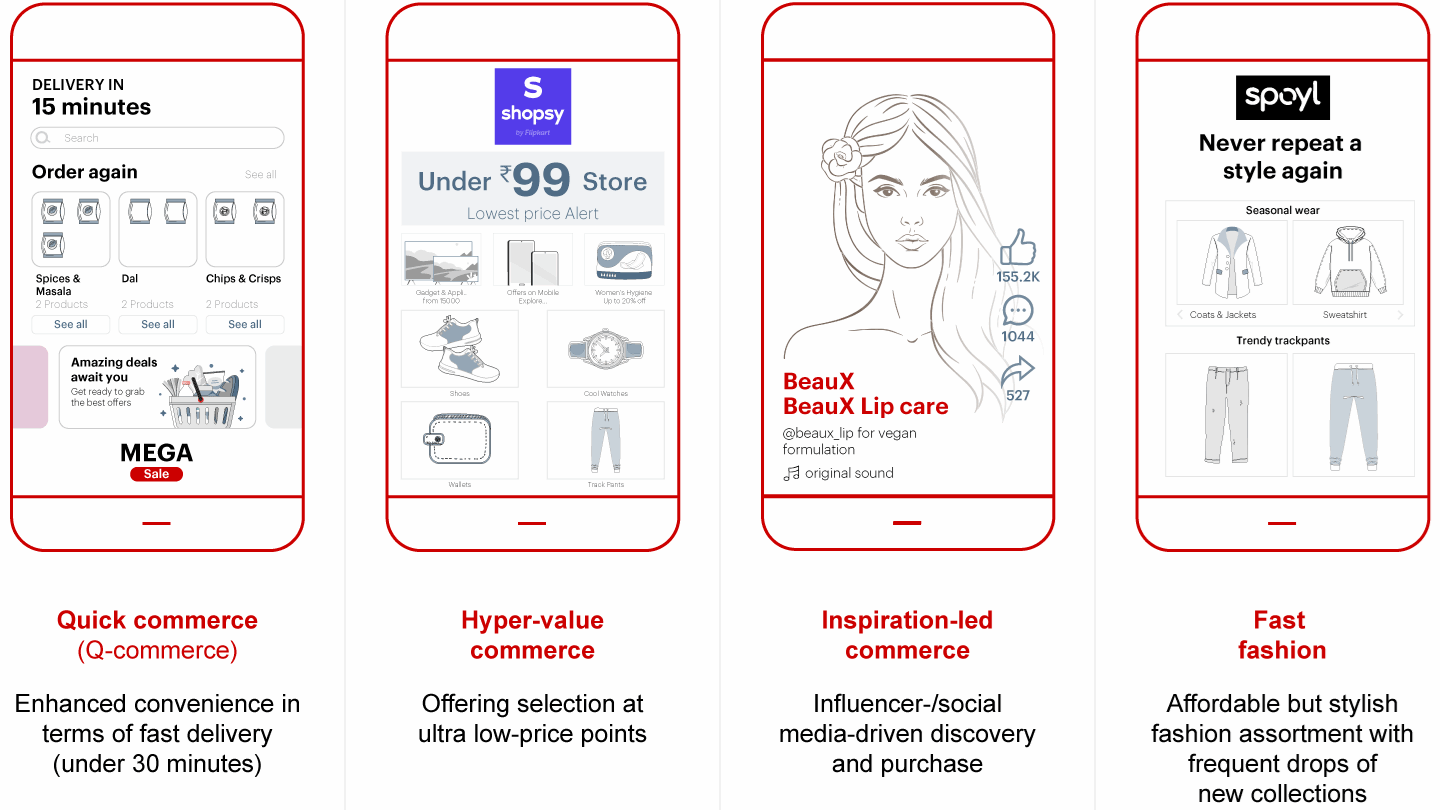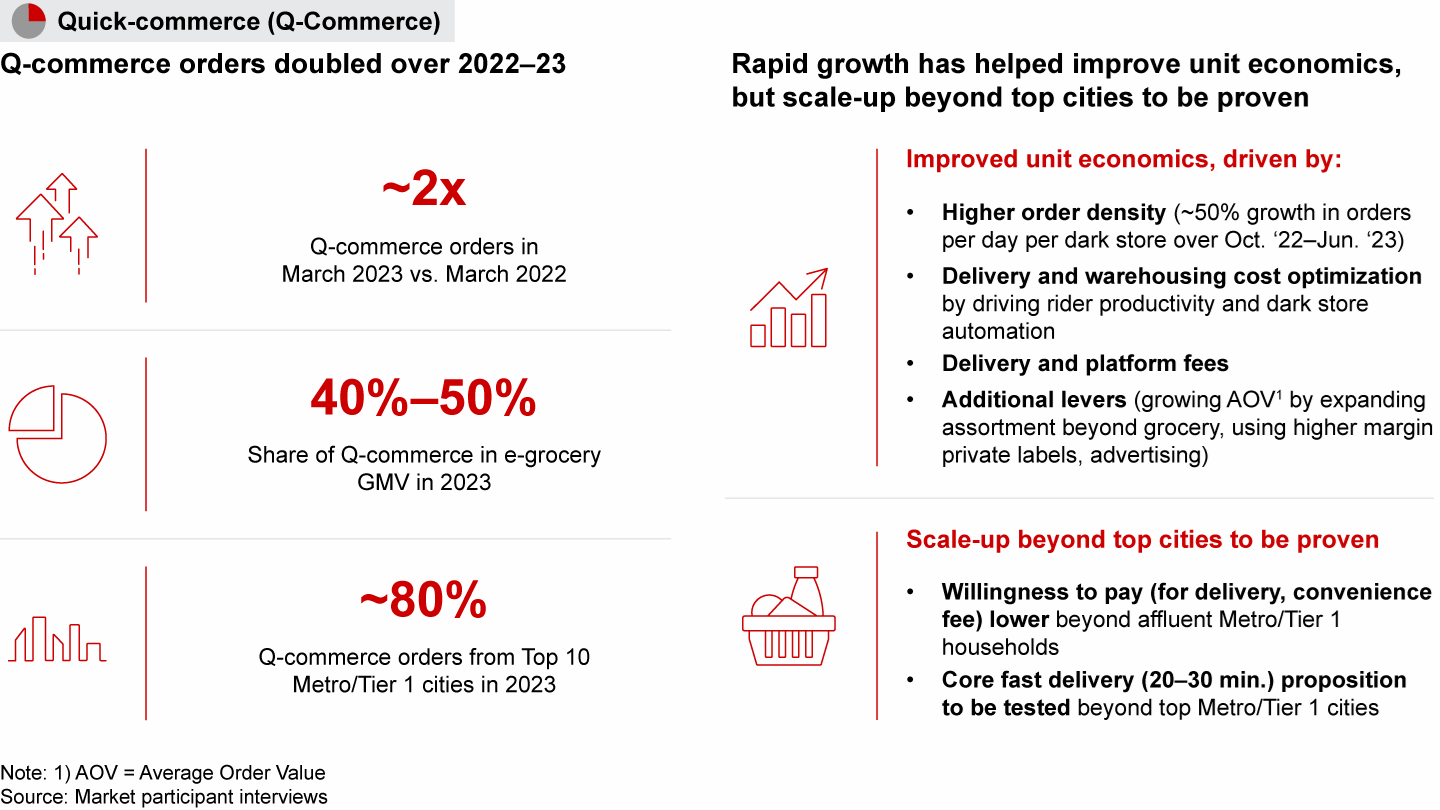Report

Executive Summary
- E-retail has been a disruptive force in global retail. Online-first retailers now make up to two-thirds of the sales generated by the ten largest global retailers—a three-fold increase over the last decade. This trend underscores the importance of the online channel in modern retail, demonstrating a notable shift in consumer preferences.
- The Covid-19 pandemic has been an inflection point for e-retail adoption globally. The surge in online shopping induced by the pandemic has largely persisted across markets, albeit to varying degrees. In mature markets like the US and China, the annual uptick in e-retail penetration is only slightly lower or comparable to pre-pandemic levels. However, India has witnessed an acceleration in e-retail penetration following the pandemic.
- This year, we will examine five major themes that are shaping e-retail in India: long-term growth fundamentals, shopper micro-segments, emerging business models, focus on profitability, and the growing role of cutting-edge artificial intelligence.
Solid foundations: India’s long-term growth fundamentals are robust
India’s e-retail market is estimated to scale to $57–$60 billion in 2023, adding $8–$12 billion annually since 2020. The market is estimated to grow by 17%–20% from 2022 to 2023, which is slower than the 25%–30% historic growth rate. The short-term dip was driven by inflationary pressures. This pinched the consumer wallet and eroded consumer sentiment, thereby deferring or reducing discretionary spending.
Written in collaboration with
Written in collaboration with

Despite slower than typical growth, online adoption grew steadily over the last year. However, there is still massive headroom for growth. Overall, online spending is only 5%–6% of total retail in India vs. 23%–24% in US and 35%+ in China. Three out of four trigger points for e-retail growth have played out in India: increased physical and digital access through cheaper data and logistics reach; enhanced affordability and convenience through lower logistics costs; and the emergence of digital ecosystems.
The fourth trigger point, affluence, is yet to be fully realized. Growth in GDP per capita will be critical to unlock e-retail growth over the next decade. Typically, when GDP per capita crosses the threshold of approximately $4,000, it drives a sharp increase in online spending per shopper and discretionary spending. In India, an estimated 60–70 million households will join the upper-middle- and upper-income cohorts, which in turn are likely to account for at least 85% of e-retail spending by 2028. Government initiatives such as the Open Network for Digital Commerce will further propel the growth of e-retail in India.
Thus, India’s e-retail market is expected to bounce back to 23%–25% growth levels and reach over $160 billion by 2028.
An evolving landscape: Diverse consumer micro-segments served via a growing seller base
India’s annual transacting e-retail shopper base is estimated to scale to 230–250 million people in 2023. Over 100 million of these shoppers were added over the last three years.
Diverse consumer micro-segments have become more salient. Now, 7 out of 10 online shoppers reside in Tier 2+ cities, and a third of online shoppers are part of Gen Z (born in or after 1997). About a third of online shoppers come from low-income or low-middle-income cohorts.
Simultaneously, there is a growing base of mature shoppers. Over 100 million shoppers participated in e-retail in 2019. Shoppers that were onboarded in 2019 have doubled their engagement, frequency of purchases, and spending on digital platforms over the past three years.
In the coming decade, e-retail growth will be driven by adding new shoppers and by growing online spending per shopper. E-retail platforms are investing as much in retention (the core thesis behind digital ecosystems) as they are in new shopper acquisition (via value selection and voice/vernacular offerings).
India will need multiple models to build, scale, and serve the needs of this diverse shopper base, which has varying price sensitivities, service and speed expectations, and language requirements. For example, voice and vernacular offerings are popular among new shoppers from smaller cities. About 25%–30% of first-time shoppers used these offerings in 2022, and about 60%–70% of voice/ vernacular users hailed from Tier 3+ cities.
The seller ecosystem is also exploding to cater to these consumers. Twice as many sellers were added in 2022 compared to 2021. Two-thirds came from Tier 2+ cities, and three-fourths operate in the lifestyle, home, and electronics categories. Insurgent online-first brands have emerged as a fast-growing seller cohort, with more than threefold revenue growth from 2020 to 2022. These brands resonate especially with Gen Z consumers.
Waves of change: New business models are emerging to serve consumer needs
This dynamic landscape created an opportunity for e-retailers and startups to test and scale new and innovative business models. Four e-retail models—quick-commerce (Q-commerce), hyper-value commerce, inspiration-led commerce (live commerce), and fast fashion—are emerging, and are at different levels of maturity.
- Q-commerce platforms offer hyper-convenience and rapid delivery (typically under 30 minutes). Globally, a series of quick-commerce upstarts emerged, raising substantial capital over 2020–22. The majority of these players have struggled to scale profitably. The story in India has been somewhat different. Q-commerce orders doubled over the last year, and now account for 40%–50% of India’s e-grocery spend. Leading Indian players have improved unit economics through a combination of scale, average order value growth, higher order density, and value-added fees. However, this is currently largely a metro/Tier 1 phenomenon. The top 10 cities account for approximately 80% of orders. Scaling beyond top metro/Tier 1 cities is possible but unproven.
- Hyper-value platforms deliver value to consumers, primarily by offering an unbranded assortment at ultra-low price points. Globally, the best example of a hyper-value platform is Temu, a cross-border marketplace launched by Chinese e-retailer Pinduoduo. Temu had over 200 million app downloads in 2023. In India, hyper-value platforms have seen accelerated growth. Their share of overall e-retail grew five-fold between 2020–22. These platforms appeal most to shoppers from Tier 2+ cities (which account for 70%–80% of shoppers) and low- or low-middle-income households.
- Inspiration-led commerce (live commerce) has grown rapidly in markets like Southeast Asia, where it accounted for approximately 15% of gross merchandise value (GMV) in 2022. Globally, both e-retailers and short video players are looking to capitalize on this trend. The most notable player in this field is TikTok Shop, which quickly scaled to 4% of Southeast Asia’s e-retail GMV in 2022. TikTok benefited from a unique growth flywheel created by its customer and creator franchise, differentiated discovery (powered by a best-in-class recommendation engine), and value-led proposition. In India, however, the model remains nascent.
- Fast fashion is another rapidly growing global phenomenon, accounting for over 1 in 10 dollars spent on women’s apparel. Online-first players such as Shein and omni-channel players such as Zara and H&M have each scaled to more than $20 billion in revenue. India’s fast fashion market is nascent but expected to grow at 30%–35% per annum between 2022 and 2027. Recent investments are bound to give this model a boost. Tata invested in scaling Zudio, Reliance has partnered with Shein, and Flipkart Group has entered this space with Spoyl (Flipkart) and FWD (Myntra).
Sustainable growth: Increased focus on profitability and monetization
The e-retail industry has seen a growing emphasis on profitability in recent years. Multiple retailers, such as Pinduoduo, Coupang (South Korea), and Shopee (Southeast Asia), achieved positive EBITDA over the last two years.
Beyond continued improvement in fundamental business economics, e-retailers have amped up their focus on monetization and deployed five key monetization levers: advertising, seller services, fintech, externalization of services (e.g., logistics, cloud), and subscription-based loyalty programs. Interestingly, the core monetization engine for global platforms has been different. For example, fintech contributes around 45% of Mercado Libre’s revenues via Mercado Pago, whereas advertising and seller services accounts for around 50% of Alibaba’s revenues.
The amount of time platforms take to launch monetization levers has dropped drastically over the last decade. Younger e-retailers such as Noon in the Middle East and Shopee in Southeast Asia spent only 2–4 years to launch levers like “fulfilled by x” and advertising, whereas mature platforms such as Amazon.com and JD.com took 16–18 years.
In India, advertising-led monetization continues to be the most salient. Advertising spending by brands and sellers on e-retail platforms has grown four-fold in three years. Yet, there exists massive headroom. In India, e-retail only accounts for 15%–20% of digital ad spending, compared to 25%–30% in the US and 55%–60% in China. An increasing number of brands and sellers recognize the value of this medium.
Generative AI: A transformative enabler
Generative AI will fundamentally alter the e-retail experience. A series of high-impact use cases are emerging that will positively impact the shopper and seller journeys. E-retailers are looking at the technology to disrupt five areas: discovery, seller enablement, targeted marketing, customer support, and business efficiency.
Global e-retailers have adopted multiple use cases, from designing personalized advertising campaigns to using chatbots for faster customer service. Flipkart Group has been the torchbearer of generative AI applications in India’s e-retail space, with multiple live experiments. Most notable are end-to-end virtual shopping assistant “Flippi” by Flipkart and smart search tool “MyFashion GPT” by Myntra; these aim to make online shopping even more akin to the offline shopping experience.
Future generative AI applications hold immense potential in e-retail and could transform the shopper journey entirely. The technology can have a high impact on multi-modal consumer journeys, powered by individual users’ personal preferences.
E-retail has made an indelible impact on the country: it has democratized shopping, helped small and medium-sized business grow, and created scalable employment. The next chapter in India’s e-retail growth promises to be even more exhilarating, as the industry pushes boundaries and pioneers new frontiers.
Solid foundations: India’s long-term growth fundamentals are robust
Globally, e-retail boomed over the last decade


Covid-19 accelerated e-retail adoption with some markets sustaining uptick


In India, e-retailers are adapting to unique structural characteristics


Indian e-retail has grown $8–$12 billion annually since 2020 and is now at $57–$60 billion


E-retail comprises 5%–6% of total retail spend in India, indicating massive growth headroom


Three out of four trigger points for e-retail penetration have been met


Digital access is nearly pervasive in India, thanks to low data prices


Lower logistics costs helped e-retailers expand reach, deliver faster to customer


Fintech growth enhanced affordability and convenience; UPI powers more than half of digital retail payments


Affluence will spark e-retail growth and shift consumption


As GDP per capita rises, it will unlock spending and boost e-retail growth


An evolving landscape: Diverse consumer micro-segments served via a growing seller base
India added ~120 million online shoppers over 2019–22 and still has room to grow


Distinct consumer micro-segments remain salient for e-retailers


Voice and vernacular offerings helped e-retailers onboard and engage new shoppers


E-retail spending per customer doubled over the past three years


The seller ecosystem is evolving to serve new and mature digital shoppers


In India, more than half of the seller base hails from seven cities, creating seller hubs


Insurgent online-first brands are growing fast


Insurgent brands leverage e-retail for growth, even as they adopt omni-channel strategies


Waves of change: New business models are emerging to serve consumer needs
Four new e-retail business models are emerging


Q-commerce will account for 40%–50% of e-grocery GMV in 2023


Hyper-value platforms have grown five-fold in India


Inspiration-led commerce has scaled globally, TikTok Shop being the best example


The live commerce market is nascent in India


Indian retailers are experimenting with fast fashion, which has surged globally


Sustainable growth: Increased focus on profitability and monetization
Multiple e-retailers have become profitable at scale in the last decade


Industry leaders dramatically reduced the time it takes to launch monetization levers


Global e-retailers use multiple monetization levers, but advertising is the core lever in India


E-retail ad spending quadrupled, yet there’s still massive potential for growth


Generative AI: A transformative enabler
Generative AI will fundamentally change e-retail


Certain e-commerce platforms have launched shopping assistants to make product discovery easier


Global e-retailers are building generative AI solutions for seller enablement

